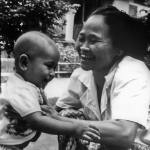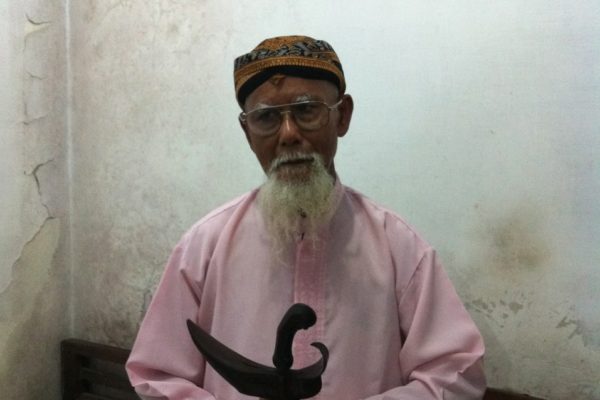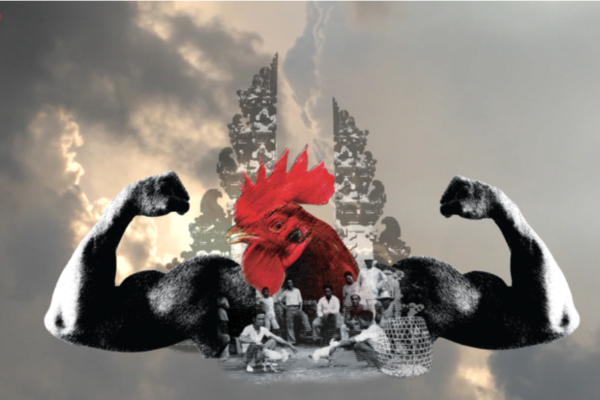Despite the rich history of innovative methods and techniques employed by documentary filmmakers across a range of genres, there seems to be little awareness or integration of the findings and approaches of psychological anthropology in ethnographic film. Similarly, many psychological anthropologists are less than aware of those films that could be relevant to their own research and teaching. This is a pity, as films can offer the opportunity for students to more directly and viscerally experience some of the concepts and material we teach. In addition, it keeps them engaged and alert in class. In both my ethnographic film and psychological anthropology classes, I use film extensively.
In previous posts on this blog I have addressed why I choose to make films and why I think there needs to be more engagement and integration between psychological and visual anthropology. Now I want to share some of my favorite films that I have used as models in my own filmmaking, incorporated into my syllabi, and returned to again and again while thinking through key concerns in psychological anthropology and ethnographic method. I have taught with all these films because each illustrates different concepts and concerns in psychological anthropology in its own way.
This list revisits some familiar standards and proposes some new additions to the psychologically oriented ethnographic film canon. Some of these are produced by, or in collaboration with, anthropologists, while others are made independently of the field.
1-3. The early films of Margaret Mead and Gregory Bateson:
Trance & Dance in Bali (1952), 22 min. New York University Film Library. New York.
Bathing Babies in Three Cultures (1951), 11 min. Pennsylvania State University. University Park.
Karba’s First Years (1952), 20 min. Pennsylvania State University. University Park.
Gregory Bateson and Margaret Mead shot thousands of feet of film during their 18-month fieldwork in Bali in the mid-1930’s, setting an early precedent for psychological anthropologists interested in using visual methods. They integrated hundreds of stills in their classic Balinese Character, which I highly recommend as a model—in many ways still unmatched 70 years later—in integrating photography with ethnographic analysis. While they initially viewed this material purely as data, several decades later they edited this footage into a series of influential and now classic short films; Trance and Dance in Bali (1952), Bathing Babies in Three Cultures (1951) and Karba’s First Years (1952). Mead later became a vocal advocate for integrating visual approaches into anthropology proper and championed the role of photography and film in what she called “a discipline of words.” While the narrative approach in the film is quite dated (e.g. Mead’s almost continual voice-over in each film not only giving interpretation but describing exactly what can be seen on the screen) they were groundbreaking in their time for their utilization of film.
These films are relevant to topics of childrearing, comparative human development, and altered states of consciousness. Go here on the blog for more on Mead’s use of film.
4. Robert Gardner’s Dead Birds (1963). 83 min. Documentary Educational Resources. Boston.
This film was shot over the course of 6 months in the highlands of New Guinea, as part of a much larger research expedition sponsored by the Film Study Center of Harvard’s Peabody Museum and the Netherlands New Guinea government to make a comprehensive anthropological study of Dani tribal life in the Baliem Valley of Papua New Guinea. Dead Birds has been heralded as the first modern ethnographic film, and it is a compelling piece, which I can watch over and over. The film captures both mundane and dramatic aspects of Dani daily life, from sweet potato farming to violent—and fatal—warfare, resulting in a cinematic exploration of aggression and human mortality through the perspective of two characters: Weyak, an older farmer and warrior, and Pua, a young swineherd.
Gardner has been criticized for taking license with his emphasis on the visual, sensory, and allegorical aspects of his work rather than on the subjective realities of the subjects in this and some of his other films (for example in Ruby 1991), but this issue can be explored to pedagogical benefit, as instructors can use the film to spur class discussion about the rhetorical effects of voiceover and narration in relation to the underlying philosophy and goals of psychological anthropology. Dead Birds can also be seen in the context of the zeitgeist of the 1960s, with its focus on human aggression and on laying bare “Man’s” supposed basic nature, à la Man the Hunter (1969) and The Naked Ape (1967). The rest of Gardner’s impressive oeuvre, such as The Nuer (1971), Rivers of Sand (1974), Forest of Bliss (1986), and more can also be mined for additional relevant material.
5. Frederick Wiseman’s Titticut Follies (1967). 84 min. Zipporah Films. Berkeley.
Over the past five decades, acclaimed documentary filmmaker Frederick Wiseman has used his interpretation of “Direct Cinema” techniques to capture human behavior in various institutional settings, from welfare offices to schools to ballet companies and boxing rings. His first film, Titticut Follies, was shot at Bridgewater State Hospital, a state-run Massachusetts hospital for the “criminally insane”, and remains one of his most (in)famous works for its depictions of challenging conditions inside the hospital. The film, which was banned under a court decision brought by the warden and guards/attendants at the hospital can be content for ethical discussions about the dilemmas that arise when anthropologists create representations that the subjects themselves object to. (For more information about the case, see the book Documentary Dilemmas: Frederick Wiseman’s Titticut Follies here, an article in the Columbia Law Review here, and an interview with Wisemen where he discusses the film, the controversy, and how it spurred his lifelong fascination with behavior in institutional settings here).
Follies could work well on a syllabus immediately following Dead Birds as stylistically it is in some ways its polar opposite, providing raw visual documentation of both aggressive and mundane behavior without providing any voiceover or guiding context for the viewer. Again, Wiseman’s numerous other films, such as High School (1968), Welfare (1975), and more provide compelling glimpses into issues of power, authority, control and dominance in their depiction of everyday life in American institutions.
6. Hubert Smith and Neil Reichline’s The Spirit Possession of Alejandro Mamani. (1973). 27 min. Documentary Educational Resources. Boston.
One of the earliest self-professed “Case Studies in Psychological Anthropology,” Spirit Possession was part of the groundbreaking 26-part Faces of Change series, which was filmed in five countries and funded by the National Science Foundation (Miller et al. 1979-1983). The film explores the experience of an elderly Bolivian man who believes spirits possess him. It addresses the contextual nuances of his situation, and poses the question: as an aging patriarch whose peers have already all died and whose powers are waning, is Mamani depressed, is he in fact psychotic, is he experiencing a familiar but more intense version of communication with spirits than is typical for his community, or are his troubles a locally sanctioned way of abdicating his familial and social role?
The film, narrated by actor David Carradine (of Kung Fu, and Kill Bill fame!) includes observational footage of Mamani writing up his will and dispersing his property and also provides an early example of self-reflexivity, capturing anthropologists and interpreters onscreen negotiating with Mamani as he asks for medication and other treatment. It can provide interesting discussion of the roles anthropologists are asked to play, and the conundrums involved in attempting to help one’s subjects. For example, the anthropologists providing non barbiturate hypnotic sedatives, such as Valium, to an arguable psychotically depressed elderly man could have contributed to his suicidality, a point the film fails to make but in retrospect is a clear ethical issue.
7-9. Timothy Asch, Patsy Asch, and Linda Connor’s The Jero Tapakan Series. (1979-1983). Documentary Educational Resources. Boston.
While many giants of ethnographic film have been interested in healing and extraordinary states of consciousness, Tim Asch’s work with Patsy Asch and Linda Connor in the Jero Tapakan series is perhaps the most in-depth and well-known exploration of a traditional healer. Jero is a Balinese medium in a small Central Balinese village and the series first documents a healing session in A Balinese Trance Seance and then presents her reflections, analysis, and a deeper discussion of her process captured while she watches video footage of herself during the session in Jero on Jero: A Balinese Trance Séance Observed. A third film, Jero Tapakan: Stories from the Life of A Balinese Healer, provides further background and context for Jero’s healing abilities.
Used together, these films are excellent for teaching, first because they illustrate the benefits of using visual data during the fieldwork process as a tool to elicit further information about the subjective experience of altered states of consciousness or other more interior experiences. Furthermore, an original, highly detailed monograph and study guide Jero Tapakan: An Ethnographic Film Monograph accompanies the films. Including such materials as part of an educational package was fundamental to Asch’s vision of ethnographic film primarily as a pedagogical tool intended for classroom use.
It has been my experience that undergrad students may find the film a bit hard to watch, because although it is deeply ethnographic and a work of profound scholarship, the pacing and detailed focus can be perceived by some as slow.
10. John Marshall’s A Kalahari Family. (2002). 360 min. Kalfam Productions and Documentary Educational Resources. Boston.
My favorite film. Marshall’s fifty-year engagement with the Jo-hoansi Bushmen of the Kalahari, culminating in his six-hour magnum opus A Kalahari Family remains a unique contribution in the annals of ethnographic film because of its half-century focus on one family. It follows their transition from subsistence level hunting and gathering through resettlement to squalid camps, capturing their struggles with the South African military, subjugation at the hands of Afrikaans and Herero land owners, and finally, battles with various NGO’s. It provides a thorough and textured diachronic exploration of the intersection of personal experience with history and political economy, and is deeply moving as well.
My recommendation would be to jump around this film. One should certainly start with the beginning hour or so, when Marshall outlines the history of both his and Toma Samko’s family’s stories; this segment is especially compelling because of the focus on family level, hunter-gatherer life in the bush. One could then jump through the next several segments, and then focus on the last film “Death by Myth,” when the community is further ravaged by well-meaning NGO development projects, which brings the story into the present day and deals with issues of applied anthropology, globalization, and the future of indigenous peoples. The ending is heartbreaking.
To accompany this film, one could also utilize the beautiful written ethnographies by Marshall’s sister, Elizabeth Marshall Thomas, which span fifty years. Her first work, The Harmless People (1959) is so engaging and moving I used to read it to my children when they were little. Warrior Herdsmen (1965) and The Old Way: A Story of the First People (2006) are recommended as well.
11. Chronicle d’Ete (Chronicle of a Summer). (1961). 90 min. Argo Films. Neuilly Sur Seine.
Rouch’s masterpiece Chronicle of a Summer helped launch both the cinema verité movement and influenced the French New Wave Cinema. It is a groundbreaking film that explores personal experience, daily life, political economy and post-traumatic memory over the course of a summer in France. The film is grounded in a self-conscious attempt at reflexivity and a critical deconstruction of the method of filmmaking itself. The filmmaker and anthropologist are active participants in the film along with the subjects of the film, in the planning, execution and analysis of the screening of a rough cut at the end of the film. It all makes for a fascinating mélange, so even though the style may be hard to follow for some students it is a must for exploring method and reflexivity.
Rouch’s other films, such as Les Maitres Fous (The Mad Masters, 1955), Moi, Un Noir (Me, A Black, 1958), Jaguar (1955), and La Pyramide Humaine (The Human Pyramid, 1961) are unfortunately rather hard to find, but well worth the effort if one can obtain them. See DER’s tribute website to Jean Rouch with information about his life and filmography here.
12. Ronald C. Simons’s Latah: A Culture-Specific Elaboration of the Startle Reflex. (1983). 39 min. Penn State University Media Sales. University Park.
A study made by psychiatrist and ethnographer Ronald C. Simons in 1983, this film illustrates a putative “culture-bound disorder” that is a variation on a hyper-startle response and represents a particular approach in the history of transcultural psychiatry. While again the production values are a bit dated, the film is fascinating for its exploration of psychological exotica. The debate in the volume Culture Bound Syndromes: Folk Illnesses of Psychiatric and Anthropological Interest (1986) between Simons and Kenny provides excellent material for either a written assignment on the relation between culture and putative mental disorders, or for philosophical debates on the relation of culture, biology and interpretive models in understanding just what is and is not a “mental illness.” This film can also be taught alongside Hildred Geertz’s article “Latah in Java: A Theoretical Paradox” (1968).
Interestingly, when anthropologists discuss my work on Tourette’s Syndrome in Bali (in Volume 2 of the Afflictions series), they almost always ask me “Do Indonesian’s mistake Latah for the symptoms of Tourette’s” and vice versa? I did repeatedly ask my subjects in Bali and Java this question, and the typical response was puzzlement and then bemusement. After explained why I asked, they understood why I would think there is a connection, but locally no one has ever made this particular association.
13-15. Kazuo Hara Films
Sayonara CP (1972). 82 min. Facets. Chicago.
Extreme Private Eros: Love Song 1974. (1974). 98 min. Facets. Chicago.
The Emperor’s Naked Army Marches On (1987). 122 min. Imamura Productions. Tokyo.
Links to the full films on Youtube, in original Japanese without subtitles:
Sayonara CP: http://www.youtube.com/watch?v=qaM_iBvXCgg
Extreme Private Eros: http://www.youtube.com/watch?v=WMhjxk1weMc
Emporer’s Naked Army: http://www.youtube.com/watch?v=FDkrunQwoLc
Kazuo Hara has been called “Japan’s Outlaw Filmmaker.” Having achieved a kind of cult status amongst film buffs, the jarring, fascinating, and at times painfully intimate films of this documentarian remain little viewed or studied in the United States. Yet they should be of primary interest to psychological anthropologists in the ways they depict socially marginalized subjects and deal with complex topics such as the lived experience of disability, obsessive love and sexuality, and the lingering traumas of war. The films are so detailed, fascinating and original I will leave it to the readers to discover them. Highly recommended for an exceedingly original use of cinema.
16. Ross McElwee’s Time Indefinite. (1993). 114 min. First Run Features. New York.
Link to film clip: http://rossmcelwee.com/timeindefinite.html.
McElwee’s work, from Sherman’s March onwards, has been an amalgam of the personal documentary, ethnography, and folkloric film. McElwee’s work is personal, political, and philosophical at the same time as he turns the camera on himself. Time Indefinite deals with basic human challenges that occur over the life cycle: grief at the death of a parent, joy at the birth of a child, and the ongoing negotiations involved in being part of a family.
17. Deann Borshay Liem’s First Person Plural. (2000). 60 min. MU Films. Berkeley.
Link to trailer and information about the film available here.
This is a film I frequently show to my classes. It is an autobiographical account of Dean Borshay Liem’s journey as an 8 year old from a Korean orphanage to life with a middle class American family, and then her “roots” exploration of what really happened in this transition as she returns repeatedly to Korea to rediscover her family, herself and her identity. It is a fascinating exploration of identity, development and personal experience across culture and time.
The film is deeply personal, emotional and moving. It also uses some original graphic and stylistic elements integrating camera moves, archival footage, and personal home movies. It is highly recommended, and students always love it.
18. Socheata Poeuv’s New Year Baby (2009) 80 Minutes. Broken English Productions. New York.
Similar to First Person Plural, New Year Baby follows the filmmaker’s journey back to Cambodia, in the process uncovering and exploring the horrors of the Khmer Rouge’s brutal genocide as seen through the eyes of her family. Hers is a very moving story, and students can easily relate to the young and dynamic Cambodian American filmmaker.
While thoughtfully shot and deeply personal, I consider several of her portrayals of encounters with putative perpetrators to be problematic. However, this provides good material for a discussion about the ethical dilemmas anthropologists and filmmakers must grapple with in their explorations of human’s capacity for evil. I myself dealt with a number of these in my exploration of the Indonesian mass killings of 1965 in my film 40 Years of Silence. The phenomenal film The Act of Killing also delves into this complex and horrific issue at great length.
19. Lauren Greenfield’s Thin (2006). 102 min. HBO. New York.
Complete film is available on Youtube here.
Lauren Greenfield has developed a remarkable body of both still and documentary photography. Thin, shot over the course of multiple months in an inpatient treatment center for people with eating disorders, is graphic and disturbing in both its exploration of the devastation of this disorder and in its depiction of the at times extreme lengths the treatment center program and staff will go to in their attempts to manage and treat severe cases of anorexia nervosa, bulimia and related disorders.
I find Greenfield’s gaze in this film at times sympathetic and at times bordering on the contemptuous in the way the treatment providers (and at times patients) are graphically exposed. She takes a position not unlike Wiseman in Titticut Follies, in portraying the systems of control and dominance treatment providers are forced to engage in. But, as a result of how the film is shot and edited, the viewer becomes immediately intimate with the graphic nature of “clinical” techniques and yet distanced from the humanity of the staff and at times the patients. The film often disturbs students and is sure to provoke discussion. Another potential avenue for exploration in class discussion is how the community of treatment providers and the subjects themselves have received and interpreted the film.
20. Bethel: Community and Schizophrenia in Northern Japan by Karen Nakamura, reviewed for this blog here.
Then of course there are my films, all of which are relevant to some aspect of psychological and medical anthropology.
So, what films do you use in your psychological or visual anthropology courses? If there are any films not on the list that you think should be classics or included as part of a psychological anthropology canon, share these in the comments!






Lucinda Almy-Hamilton
I teach Cultural Anthropology and Psychological Anthropology at a community college. I use the film, “War Dance”, to illustrate the power of music and dance in coping with depression and trauma.
Dr. Denruth Lougeay
Most wonderful is a documentary titled “First Contact” with footage of the first white man encountering a tribe in New Guinea in the 1920’s. There is a book of the same name and it is simply fantastic. Please add it to your list!
Adam Ponting
Thanks for this great list.
“First Contact” (82) is by the Australians Bob Connolly & Robin Anderson; they made two sequels, Joe Leahy’s Neighbours (89) and Black Harvest (92) about Joe Leahy, son of that ‘first white man’, living between two cultures. Amazing movies. Connolly & Anderson made other fascinating documentaries too, among them Rats in the Ranks (local politics in Sydney) and Facing the Music (in a university music department).
Other masterpieces which may be suitable: Grizzly Man, Gates of Heaven, Land of Look Behind, Nostalgia for the Light, The Pearl Button, Bus 174, Intangible Asset No. 82.
paula penton
You will be glad to know that “First Contact” is now available
on Netflix!